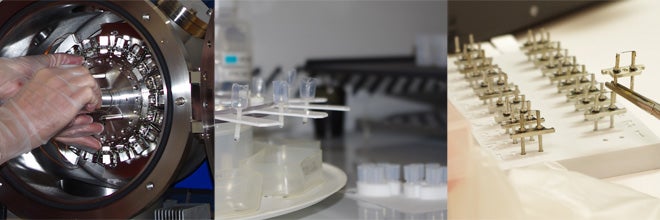
Among the most sensitive tests of the mass spectrometer’s ion counting system, as well as the cleanliness of the clean laboratory and chemical separation procedures, is the analysis of radiogenic Pb/U ratios in accessory minerals like zircon. We routinely utilize our in-house mixed 205Pb-233U-235U isotopic spike for tectonic and petrologic problems, and the EARTHTIME mixed 202Pb-205Pb-233U-235U isotopic spikes for timescale calibration, standard characterization, and other high-resolution applications. The total common Pb of our zircon analyses reflect blank contributions from the laboratory, which are controlled at < 0.3 pg ; these low procedural blanks allow the analysis of single zircon grains as young as Pleistocene, as well as fragments of grains plucked from grain mounts previously analyzed by in situ methods, at precision of ≤ 0.1% (2-sigma).
Purified Pb and U from single dissolved grains or grain fragments (e.g. plucked from grain mounts) are loaded together with a silica gel – phosphoric acid emitter solution on single Re filaments. Pb and U isotopic compositions are measured sequentially as Pb+ ions (emitted at approximately 1200-1300°C) or UO2+ ions (emitted at approximately 1400-1600°C). Pb isotope ratios are measured in either of two modes: for large samples, by a two sequence dynamic routine peak jumping 205Pb between Faraday and Daly detectors to establish a real-time gain; or for small samples by peak jumping all isotopes on the Daly detector. U isotope ratios are measured by static collection on three Faraday cups.